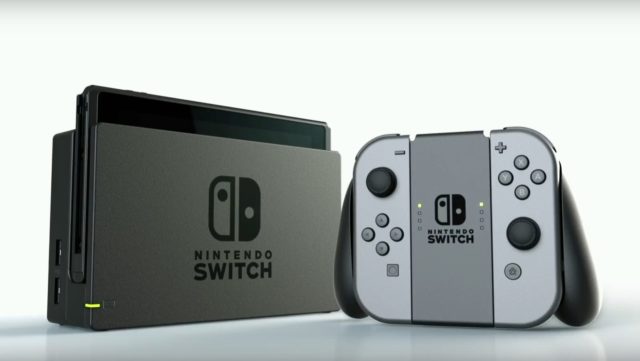Nintendo has finally unveiled key details about its new console dubbed the Switch. Nearly three months after the console’s reveal, consumers finally know price point, launch date and certain specifications that will help drive purchasing decisions this year. In addition to the unit itself, livestream viewers were treated with previews of several new games being developed for or ported to the console, including The Legend of Zelda: Breath of the Wild, FIFA 17 and The Elder Scrolls V: Skyrim.
For a suggested retail price of $299.99 US, the Switch will launch simultaneously in the US, UK, Japan, Canada, Hong Kong and other territories on March 3, 2017. At that time, a dedicated online service will be available for multiplayer, along with a dedicated app for smart devices that will offer additional features. The service will be free until the fall, at which time it will become a paid subscription similar to PlayStation Plus or Xbox Live Gold. The Switch will be available for pre-order beginning January 21, and unlike previous consoles, will not feature region locking for its games.

With the Wii, Nintendo changed the way the general public viewed video games from stereotypes of teenage boys on the couch to entire families playing together. The Switch continues this message by building on the success of previous consoles and combining popular methods of gameplay into one unit. Shinya Takahashi, director and managing executive officer for Nintendo’s entertainment, branding and development division outlined all the company’s innovations to date, from including two controllers and additional buttons to touch screen and motion control.
“Nintendo Switch has inherited all of Nintendo’s entertainment DNA and we have packed each and every one of these features into the system,” said Takahashi. “Nintendo is constantly pursuing new forms of entertainment to bring more fun and more smiles to the world and the new entertainment we will present in 2017 is Nintendo Switch.”
The new Joy-Con controllers do more than simply track movements—they each provide “HD rumble,” giving precise feedback to whoever is holding it. Whereas controllers were limited to generalized vibrations in the past, the Joy-Con demonstration implied that players would be able to detect the smallest of changes, such as ice cubes being dropped into a glass. The controllers also feature an infrared sensor that can tell distances and the difference between shapes—adding new possibilities to future game and user interface design.
Launch games such as 1-2 Switch and Arms emphasize how Nintendo is promoting the console as a system for parties, similar to how family gatherings helped bring the Wii to success. The Switch’s portability and included Joy-Con controllers make it perfect for having fun at get-togethers.

Indeed, the company is known for doing its own thing and taking digital entertainment to another level, but the risk of trying new things is not without its pitfalls.
“To many, the Switch is Nintendo’s long-awaited answer to recent challenges,” commented SuperData CEO, Joost van Druenen. “Especially the investment community, which has been highly critical of the performance of Nintendo’s last console, the Wii U, which sold around 15 million units. The device failed to replicate the blockbuster success of the Wii, which sold more than 100 million units. This, in combination with Nintendo’s late entry into the $40B mobile gaming market, has raised the level of criticism among investors and industry observers, even when consumers remained loyal.”
The Japanese giant isn’t one to give up, however, and if the Switch proves anything, it’s that Nintendo is poised to take on the future of gaming—whatever that may be. Capitalizing on the popularity of mobile games, Nintendo’s foray into the arena has thus far been a success. “Super Mario Run, released almost a month ago, has been downloaded by an estimated 96 million people worldwide, earning $43M to date,” van Druenen observed, “and Pokémon GO (released in the summer of 2016) has so far earned $894M since launch (up to and including December 2016). The two titles are largely regarded as evidence of Nintendo’s continued relevance and the strength of its brands.”
Speaking of brand strength, Nintendo hopes to increase sales by launching The Legend of Zelda: Breath of the Wild on the same day as the Switch. With over 50 companies developing over 80 games for the unit, time will tell if strong titles will be enough to bolster support for Nintendo’s hybrid console. In the meantime, the Switch will go on tour across the US and Europe so consumers can try it out for themselves.
As demonstrated in the Switch reveal video, Nintendo is taking a serious look at the world of eSports. “The prominent featuring of its multiplayer game, Splatoon, in the context of competitive gaming suggests that Nintendo is looking to also capitalize on recently emerged categories like eSports,” van Druenen observed. “In 2016, eSports was valued at $892 million, with 135 million regularly watching competitive gaming tournaments. Splatoon has so far sold around 5 million units worldwide (both digital and physical sales).”

